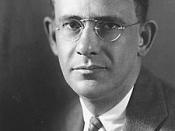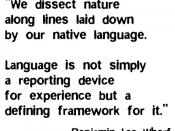ÃÂThe Sapir-Whorf hypothesis (SWH) states that there is a systematic relationship between the grammatical categories of the language a person speaks and how that person both understands the world and behaves in itÃÂ. (Wikipedia) The Sapir-Whorf hypothesis was created by two American linguists, Edward Sapir and his student Edward Lee Whorf, in the early 1930ÃÂs. It is considered to be a mould language theory, which ÃÂrepresents language as a mould in terms of which thought categories are castÃÂ. (Bruner et al. 1956). At a very basic level, the Sapir-Whorf hypothesis consists of two linked ideas, that of linguistic relativity, where the language you speak will influence your outlook on the real world, and a stronger idea of linguistic determination, where our thinking and interpretation of the world around us is established by the language we speak.
It was Edward Sapir who theorized that our viewpoint on the world is affected by the language.
WhorfÃÂs theory was drawn from a study of Hopi Indians, which stated that their language has no concept of time as an objective being. From this, Whorf attempted to prove the linguistic relativity theory by looking at the way the Hopi rely on preparation, such as planning events in advance, does show a concept of time. In this case it is just time continuing along instead of matching the western way of dividing up time. He claimed that this concept of time matched their linguistic differences, which in turn shows language determining thought. Sapir and Whorf agreed that it is ones culture which determines language, which then determines the way our thoughts and experiences of the world are categorized.
One of the main problems with WhorfÃÂs theory is the idea of causality. Whorf cannot prove if the language determined the thought, or if it was in fact...


